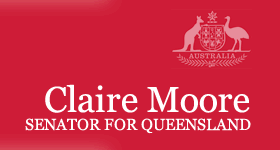Senator MOORE (Queensland) (19:40): We all know that anniversaries are important, and one of the key messages out of the original Closing the Gap statement 10 years ago was that every year we would bring back to this parliament the experience and the knowledge that had been gained the previous year, to ensure that we remembered exactly what the original Closing the Gap statement had been about and that we, as a parliament, would listen to people who are living the experience: people in Aboriginal and Torres Strait Islander communities across our nation and the people who work in those areas. We said that we would bring the research and the knowledge we had from across the nation back to the parliament and take notice of what had occurred and how we were progressing. We made a solemn commitment, together as a parliament, to Aboriginal and Torres Strait Islander people that we would acknowledge there was a gap. In fact, for the first time in the parliament it was clearly stated that we as a nation accepted that there was not genuine equality in our nation. We acknowledged that people living side by side with us were not benefiting, the way that everyone should, from the value and the wealth of our nation. First of all we acknowledged that there was a gap and then, together, we made a commitment that we would work to close that gap.
Now, 10 years down the track, the government has decided that we will do a refresh program around the whole process. But during the refresh it's important we understand that this is not moving away from the original process; it's just taking note and ensuring that we work effectively together and become stronger. On that basis, it's important to remember the goals from the original Closing the Gap statement 10 years ago. They were deliberately challenging targets. They were not meant to be easy. They acknowledged the situation in our community, and we said that things had to change and that there had to be concentrated effort at every level of government and every level of the community to effectively identify the gap, address the difference and then learn as we worked together to close it.
Today we heard the Prime Minister talk about the fact that there had been encouraging progress across three of the original goals of the Closing the Gap statement. But, because there has been activity across the three, we shouldn't forget that through this concentrated process of working together over 10 years there has been improvement across the board. Things have been focused now for 10 years and, whilst we may not have met the original targets in every one of the areas, we should not run away from the fact that there has been improvement. That's the idea of coming together every 10 years and assessing how we're going.
But we should not ignore the original goals of the program. No. 1-the first step, the first process-was to look at the fact that there was a gap in life expectancy in our community. That was identified, and it was shameful that there was such a gap in life expectancy. So the very first goal was to close the life expectancy gap within a generation-that is, by 2031. There has been movement, but we have not met what we'd hoped to do by this stage. But that is no reason to turn away from that incredibly important element of the commitment that we as a parliament made to the people of Australia-that is, that we would look at the health aspects of communities to ensure that we closed that life expectancy gap. So through any process of refresh we should not move away from that core goal.
We need to ensure that people in Aboriginal and Torres Strait Islander communities across the country have the clear expectation of equality in health and wellbeing. We have the support mechanisms to do that in our country. If we look at the work that has been done around the social determinants of health programs across the country, we see the range of different elements that work together to ensure that there is a basis for equality. It is so essential that we continue to work with this framework and to look at all the elements that work together to ensure that there is equality, there is safety and there is security. That will continue to be the challenge around the issue of closing the gap on life expectancy. We would halve that gap in mortality rates for Indigenous children under five within a decade, which is now, the 10th anniversary. We have not met that claim, but we have worked together to ensure that there is that national focus-and again I use that term-on something that is shameful for our community-the gap in expectation. On the mortality rates for children there has been progress, so we need to assess how far we've come and what we can do in the future.
On childhood education for four-year-old Indigenous children in remote communities, there is progress towards that goal. It is not to say that we need to have a big tick against that. A tendency that we have in parliament, in government, is to set up a checklist and, as soon as we think that we've actually achieved something, we put a big cross through it, as though there is no need for ongoing work. The message of the Closing the Gap agenda has always been that we do not cease to concentrate on the work. We maintain the effort, we maintain the engagement and we listen to and work with the people who have the lived experience. That there has been improvement in the early childhood education goal does not mean that we can say that work has been concluded. We need to continue to work in this space to maintain it. When we do that, it necessarily leads on to the gap in reading, writing and numeracy achievements, which is one where we haven't actually met the original target. No child should be able to complete their schooling without having effective reading, writing and numeracy achievements. That's the solid basis for opportunity in life, for progress and for education and employment achievements. So there has to be continuing work on that. The grade 12 attainment rates have again improved. The gap in employment outcomes between Indigenous and non-Indigenous Australians has been a shared agreement across this parliament for many years.
All the goals work together. The idea was not to say that one goal was more important than another. This was a concentrated process of determining where the key gaps were and then working together as governments across the board to ensure that we have the best possible response. What we have continued to know, when we have this annual focus on the Closing the gap report, is that there is more work to be done. The reminder to all of us is that it is important that we maintain that we as a parliament come together, once a year, to assess how we're going and to look at how we can better the process and how we can work into the future.
I have always felt that this is a positive program. I know that there are elements who say that we concentrate on the negativity. I have always felt it was a positive process to have parliamentarians who were prepared to work on, and to speak openly about, what we have done and what we can do better. I am very hopeful that the refresh process-though I have to admit I do not like that term-will actually re-energise the response. We will work closely with Aboriginal and Torres Strait Islander communities, we will truly review what we came together for and committed to 10 years ago and we will rebuild that commitment into the future. This is a positive process, but the incredibly important element is that we work together.
As always, the message we heard last week, when people came together in this place to talk about the Closing the Gap process and to identify the fears and concerns about where it would go next, was the clear concern about the need to continue to do this together. Single groups of parliamentarians will never make the effective change that we must have. The ongoing message is that we listen to our first peoples, we respond to their needs and we accept the wisdom, the resilience and the power of their lived experience over many generations. Only then will we be able to continue the very important commitment that we made 10 years ago, which is that the gap exists and the gap can be changed, but only if we continue to work together.
Question agreed to.




